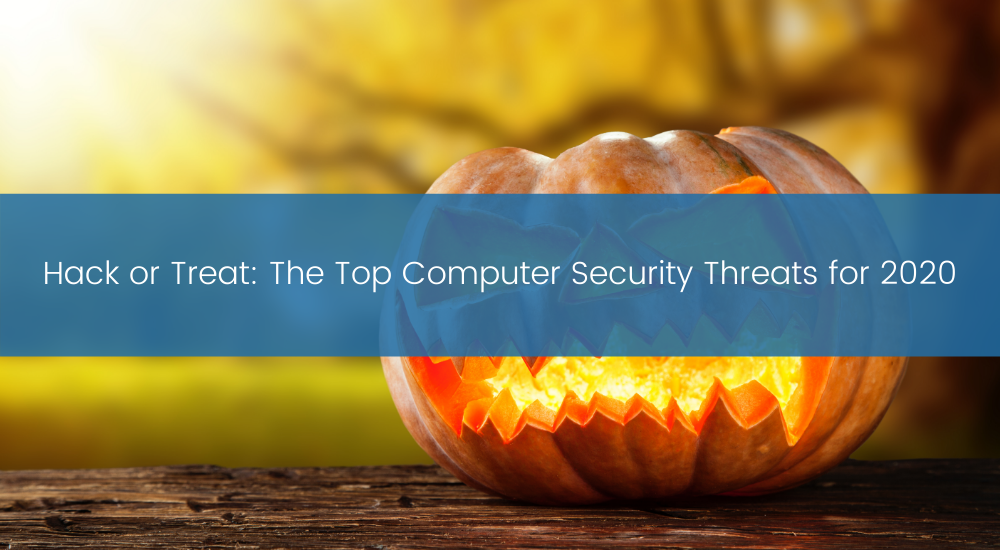
Cybersecurity has become one of the major issues threatening organizations’ safety and financial well-being throughout the world. In fact, EY recently cited cybersecurity as the top issue companies will face over the course of the next decade.
October is National Cybersecurity Awareness Month (NCSAM), so we’re taking a look at the top computer threats to be aware of in 2020 and beyond. Our focus on cybersecurity is meant to bring awareness to the increasingly digital nature of our world while preventing damage caused by digitally malicious content.
We’ll provide tips to help protect yourself and your business against the threat of potential hackers and security issues.
1. Phishing (email and mobile)
Phishing continues to be a top concern for organizations across the spectrum due to its relative frequency. Texting and email continue to be popular communication channels used to execute the attacks, as people are typically unaware of potential security issues. It can be challenging to track, and people may be unaware they’re being victimized until it’s too late.
McAfee reported a 71% increase in mobile malware attacks in Q1 of 2020—numbers that will likely continue to rise in years to come. Employees should be well versed in security protocols and practice due diligence when accepting invitations or attachments from unsolicited contacts—especially on company devices.
2. Ransomware
Ransomware continues to be an issue for companies of all sizes. Although the occurrence of ransomware has dropped recently, organizations must be wary of looming concerns. A woman in Germany recently suffered a deadly fate when ransomware shut down a hospital causing systems to malfunction, thereby preventing critical care.
Using security monitoring systems that run 24 hours a day, seven days a week, 365 days a year, can help to oversee potential issues and pinpoint problems before they occur.
3. Remote Work
Pandemic concerns have forced remote employees to perform job functions from their homes. While this has created increased flexibility for employees—security concerns centered around home networks have heightened. In fact, a 300% increase in data breaches has occurred in recent months. Employees have been performing job duties with personal devices, thereby increasing problems and issues.
Organizations should have strict policies in place if personal devices are used for business. Furthermore, sensitive data should not be downloaded onto personal devices. Organizations should require VPNs and two-factor authentications to increase security options. IT departments should also install regular updates remotely to maximize security coverage.
4. Insider Attacks
Many threats occur from within organizations. Disgruntled, furloughed, or careless employees can cause major data breaches to occur. Companies should focus on preventing insider attacks by monitoring employees and practicing security procedures.
Role-based security policies should be created where employees are granted privilege roles and data access only as needed. This may help prevent the occurrence of many insider attacks.
5. Data Leaks
The rapid transition towards digital transformations has caused an increasing number of data leaks. According to Risk Based Security, the first quarter of 2020 saw a 273% increase in exposed data records.
Implementing a solid business continuity plan with a measured digital transformation path can help companies keep operations flowing even during times of uncertainty. Organizations should always have plans in place in case of potential attacks or data breaches.
6. IoT and Smart Devices
According to Norton, by 2025, there will be more than 21 billion IoT devices. As consumers and public entities expand their use of IoT devices, the attack surface will grow exponentially. Cybercriminals will have the opportunity to take advantage of vulnerabilities exploited through personal devices and devices such as public kiosks.
In order to mitigate the risks of potential attacks, a forward-thinking security strategy needs to be put in place. TBC has the resources to help evaluate your current environment as well as develop and implement a cybersecurity strategy.
7. DDoS Attacks
DDoS attacks have been used for years by cybercriminals, but the rise in connected devices, as well as more people reliant on online services because of the global pandemic, has exacerbated the issue. According to recent research, DDoS attacks have increased by 542% between Q1 and Q2 of 2020. Some experts believe that DDoS attacks will be one of the most common attacks because of the increased use of IoT devices. These devices are all connected to the internet with very little security protocols and can be used to power the attacks.
How TBC Can Lower Security Risks
If your business is looking to secure its systems and limit potential vulnerabilities—look no further than TBC.
As a managed services provider, TBC can lower your cyber risk profile and close gaps in security systems. By performing a Security Risk Assessment—TBC can determine the strength of your security protection and pinpoint potential vulnerabilities.
TBConsulting identifies your systems, workloads, data storage, and applications within your digital environment. We help businesses develop forward-thinking strategies to help secure your valuable data and limit the risk of cyberattacks.
If you would like to learn more about how TBC can address current organizational needs, please set up a 30-minute consultation with one of our security experts today!
.png)

